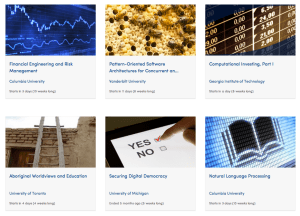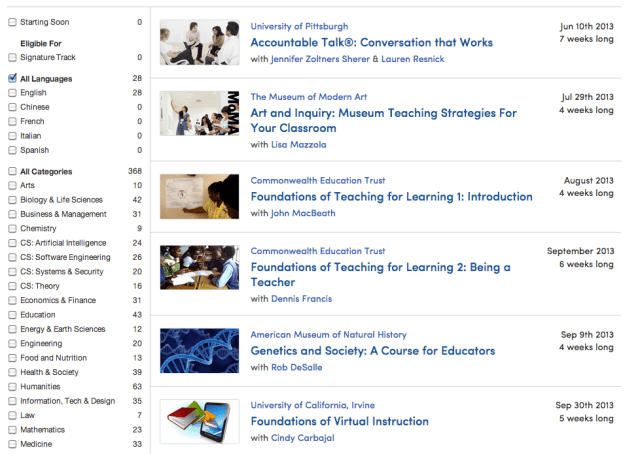While some institutions of higher learning have grown skeptical of the MOOC phenomenon spreading through its ranks (and the startups responsible), you have to give Coursera credit for keeping its foot on the gas. In less than six months, the MOOC startup has taken meaningful steps towards monetization and toward becoming a legitimate MOOC university, adding career services, verified certificates for a fee, courses for credit, along with teh addition of 29 new institutions (to bring its total to 62).
With how quickly the MOOC universe is expanding, Coursera is now positioning itself to be the first to bring the MOOC model into K-12 market. It had to figure it was only a matter of time. But, rather than bring online courses directly to kids, Coursera is starting with teachers and filling a gap in its curricular coverage in doing so. Today, the Stanford-born startup announced that, beginning this summer, it will make teacher development courses available for free on its platform.
To do so, Coursera is partnering with another set of institutions, but this time it’s focusing on those with established professional development programs, like University of Washington’s College of Education, the Curry School of Education at UVA, Johns Hopkins University School; of Education, Vanderbilt’s Peabody College of education and human development, and the Relay Graduate School of Education, to name a few.
Alongside its seven new educational partners, it’s also teaming up with more recreational institutions, including The Museum of Modern Art, the Exploratorium, the American Museum of Natural History and New Teacher Center. In other words, not only is Coursera expanding its course catalog to include the fundamentals of teacher up training and development, but it will also be allowing teachers to dive into more specific instructional topics, like “Integrating Engineering Into Your Science Classroom.”
As one can see from its new course list, the platform now allows teachers to explore a wider variety of EdTech-related topics, to learn how to better incorporate technology, engineering and the humanities into their classrooms.
EdSurge also reports that the new training and development content are expected to be made available to teachers and institutions at a lower cost than what its general ed partners are paying, which usually run from $10K to $50K.
What’s more Coursera, reportedly plans to offer certificates of accomplishment for instructors who complete the courses. EdSurge speculates that the reason for the difference in cost is likely due to the fact that the courses will be offered in shorter durations (three to four weeks) than its traditional content.
As mentioned, this partnership represents Coursera’s first foray into early childhood and K-12 education (and one of the first among the most popular MOOC players) and the first time it has partnered with non-degree-bearing institutions to help make their content available across the globe.
Like its current model, the new courses will feature video lectures, supplemental materials, peer forums and a few other interactive features. But, perhaps most important to the big picture, is that it opens up the potential for schools and districts to integrate this content into their own professional training and development programs, blended learning-style.
While Coursera says that it doesn’t have anything in the works, the new professional development program seems to set the table for its future expansion into the world of K-12. It wouldn’t be a huge stretch for the platform to begin partnering with top high school and grade schools around the country to bring its MOOC education to younger generations. Especially considering that many high school students already use its content to prepare for college.
Given its rapid expansion, this affords Coursera the opportunity to sit back and survey the space, and make that move when and if it becomes necessary or advantageous to do so. It’s easy to take the view that Coursera is over-extending itself by operating in so many different capacities at once, but putting itself within striking distance without taking the plunge seems like a smart play.
Find Coursera’s announcement here.

